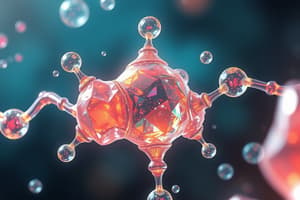Podcast
Questions and Answers
What is the result of hydrolyzing disaccharides with dilute acid?
What is the result of hydrolyzing disaccharides with dilute acid?
- Synthesis of sucrose
- Yielding of free monosaccharide components (correct)
- Formation of polysaccharides
- Breakdown of glycoproteins
What type of bond joins a sugar to a nitrogen atom in glycoproteins and nucleotides?
What type of bond joins a sugar to a nitrogen atom in glycoproteins and nucleotides?
- C-glycosyl bond
- O-glycosyl bond
- N-glycosyl bond (correct)
- P-glycosyl bond
Which disaccharide is a reducing sugar?
Which disaccharide is a reducing sugar?
- Lactose (correct)
- Trehalose
- Sucrose
- Maltose
In which organism is sucrose not formed?
In which organism is sucrose not formed?
What is the main function of sucrose in plants?
What is the main function of sucrose in plants?
What is the commercial use of trehalose?
What is the commercial use of trehalose?
What is the result of replacing a hydroxyl group in a parent compound with an amino group?
What is the result of replacing a hydroxyl group in a parent compound with an amino group?
What is the type of bond that joins two monosaccharides in a disaccharide?
What is the type of bond that joins two monosaccharides in a disaccharide?
What is the function of glucosamine in the body?
What is the function of glucosamine in the body?
What is the reaction that forms a glycosidic bond?
What is the reaction that forms a glycosidic bond?
What is the characteristic of glycosidic bonds in terms of cleavage?
What is the characteristic of glycosidic bonds in terms of cleavage?
What is an example of a disaccharide?
What is an example of a disaccharide?
What is the primary difference between various polysaccharides?
What is the primary difference between various polysaccharides?
What is the function of homopolysaccharides like starch and glycogen?
What is the function of homopolysaccharides like starch and glycogen?
Where is glycogen especially abundant in the body?
Where is glycogen especially abundant in the body?
What is unique about the structure of glycogen granules?
What is unique about the structure of glycogen granules?
Why are glycogen molecules typically stored in a branched, rather than linear, structure?
Why are glycogen molecules typically stored in a branched, rather than linear, structure?
What is the reason why glucose is not stored in its monomeric form?
What is the reason why glucose is not stored in its monomeric form?
Study Notes
Hexose Derivatives
- Hexose derivatives are sugar molecules with a hydroxyl group replaced with another substituent or a carbon atom oxidized to a carboxyl group.
- Examples include glucosamine, galactosamine, and mannosamine, where a hydroxyl group is replaced with an amino group.
- Glucosamine is a component of structural polymers, including those in bacterial cell walls.
Disaccharides
- Disaccharides are formed when two monosaccharides are joined covalently by an O-glycosidic bond.
- The bond is formed when a hydroxyl group of one sugar molecule reacts with the anomeric carbon of another.
- Examples of disaccharides include maltose, lactose, and sucrose.
- Glycosidic bonds are readily hydrolyzed by acid but resist cleavage by base.
Polysaccharides
- Polysaccharides are polymers of medium to high molecular weight, composed of repeating monosaccharide units.
- Homopolysaccharides contain only one type of monosaccharide unit, while heteropolysaccharides contain two or more different types.
- Examples of homopolysaccharides include starch and glycogen, which serve as storage forms of monosaccharides for energy.
- Heteropolysaccharides, such as peptidoglycan, provide extracellular support for organisms.
Glycogen
- Glycogen is a homopolysaccharide found in the liver and skeletal muscle.
- It is stored in large granules in hepatocytes, each containing multiple highly branched glycogen molecules with an average molecular weight of several million.
- The granules also contain enzymes responsible for glycogen synthesis and degradation.
N-Glycosyl Bonds
- N-glycosyl bonds join the anomeric carbon of a sugar to a nitrogen atom in glycoproteins and nucleotides.
Disaccharide Examples
- Lactose is a disaccharide of D-galactose and D-glucose, found naturally in milk.
- Sucrose is a disaccharide of glucose and fructose, formed by plants but not animals.
- Trehalose is a disaccharide of D-glucose, a non-reducing sugar found in insects and used commercially as a sweetener.
Polysaccharide Functions
- Polysaccharides serve as storage forms of monosaccharides, as structural elements in plant cell walls and animal exoskeletons, and provide extracellular support for organisms.
- Sucrose is a major intermediate product of photosynthesis and a principal form of sugar transport in plants.
Studying That Suits You
Use AI to generate personalized quizzes and flashcards to suit your learning preferences.
Description
This quiz covers the basics of biochemistry, specifically the hexose derivatives found in organisms. Learn about the different types of sugar derivatives and their properties.




